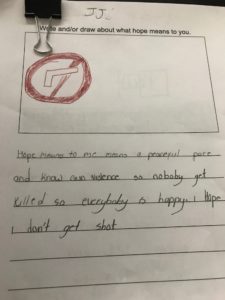Wendy’s work is absolutely beautiful. Reading her work has me thinking many things about my students, my positionality as a researcher, my research methodology and just life in general.
Though my students’ work that I’ve collected are drawings (crayons, markers and pencils) and not photographs, a lot of what Wendy wrote about photography applies to the drawings of my students. In Wendy’s work, “A Camera is a Big Responsibility,” she writes about a “photovoice” which she says, “puts cameras in the hands of people who have been left out of policy, decision-making, or denied access to and participation in matters that concern their daily lives,” (Luttrell, 2010), and it made me think of flipping, “photovoice” to “drawing-voice” where my students are given the opportunity to use drawings to represent their point of view and experiences to adults both in and outside of school who make decisions. Like Wendy, the purpose of me collecting students’ drawings around freedom dreams, racism and hope (new drawings I collected this past week) is to have students, “speak back to dominant or stereotypical images” and/or ways of being, knowing, living, and existing in America.
Like Wendy’s, I believe that the drawings of students will allow me to gain insight into my students’ social worlds and how class, race, and gendered meanings of selfhood are developed, understood, defined, redefined, framed, and reframed. . In chapter 3 of Wendy’s (2003) book, “Pregnant Bodies, Fertile Minds: Gender, Race, and the School of pregnant teens,” there were so many words and phrases that I want to use in my lens when collecting and analyzing the drawings of my students. Such as the notion of, “inside story,” “innocent, cute, and small,” “holds multiple truths and express mixed feelings about growing up hard and fast,” “express a sense of loss of power,” “model of the self as a ‘barricade’ against the world” vs “middle-class model of the self as ‘flower’ opening up to the world and a sense of ‘soft’ individualism born of a life of comfort,” “standing alone,” “making it on my own,” “facing the world by myself,” “being the object of others’ gaze,” and “them-me formulation.”
Attached, you will find a drawing and words of JJ, a third grader in my class. The guiding prompt for this drawing and writing activity was, “Write and/or draw about what hopes mean to you.” I am still processing his work, and the work of many of my students, who shared similar sentiments as JJ, at the age of 7, 8 and 9. So many of the words and phrases of Wendy’s work with the pregnant young women are deeply connected to the work of my elementary school students.

From Wendy’s work to my work of kids’ drawings,I want to know:
- What “aesthetic” questions should I ask?
- What “autobiographical” questions should I ask?



